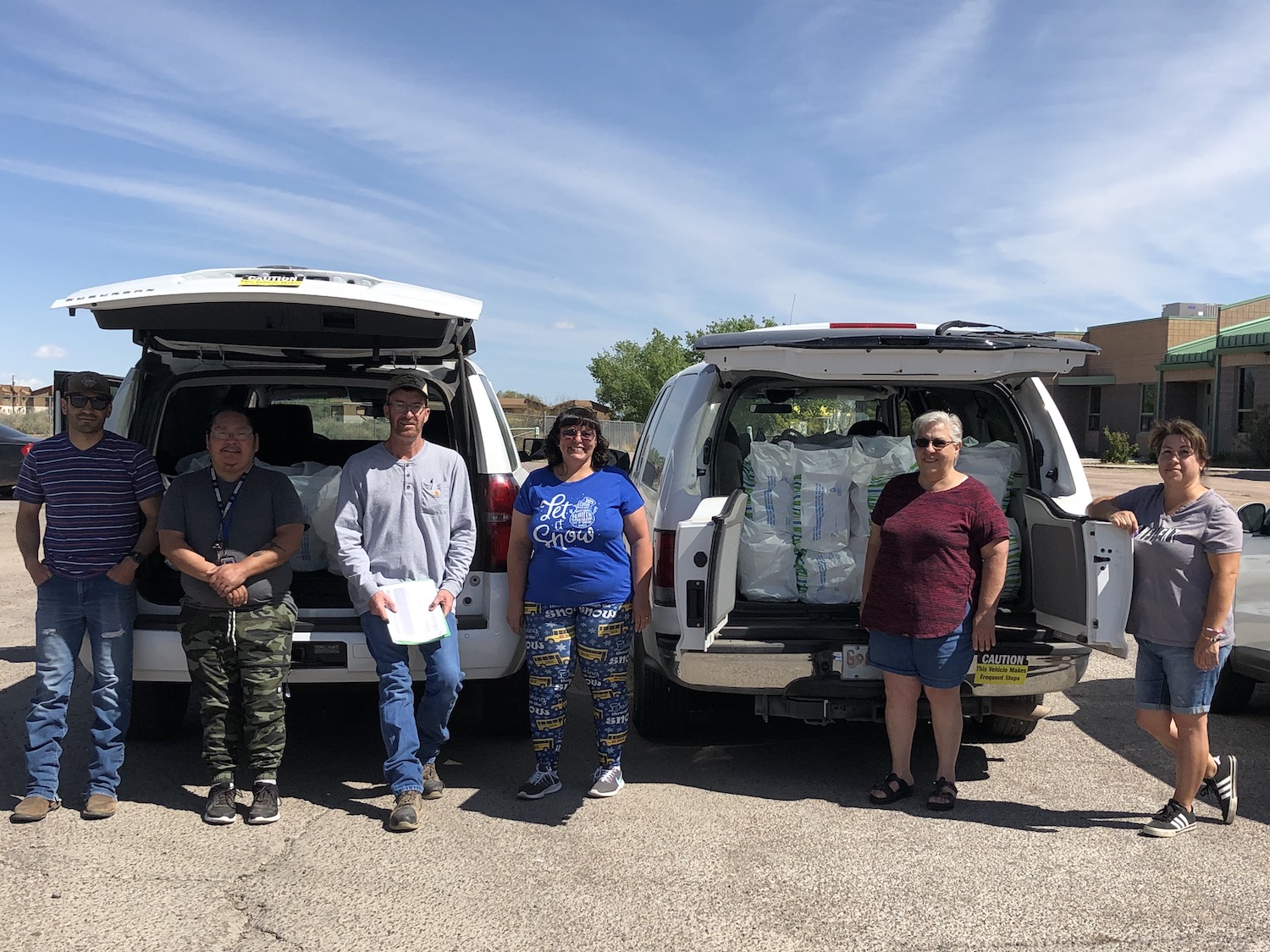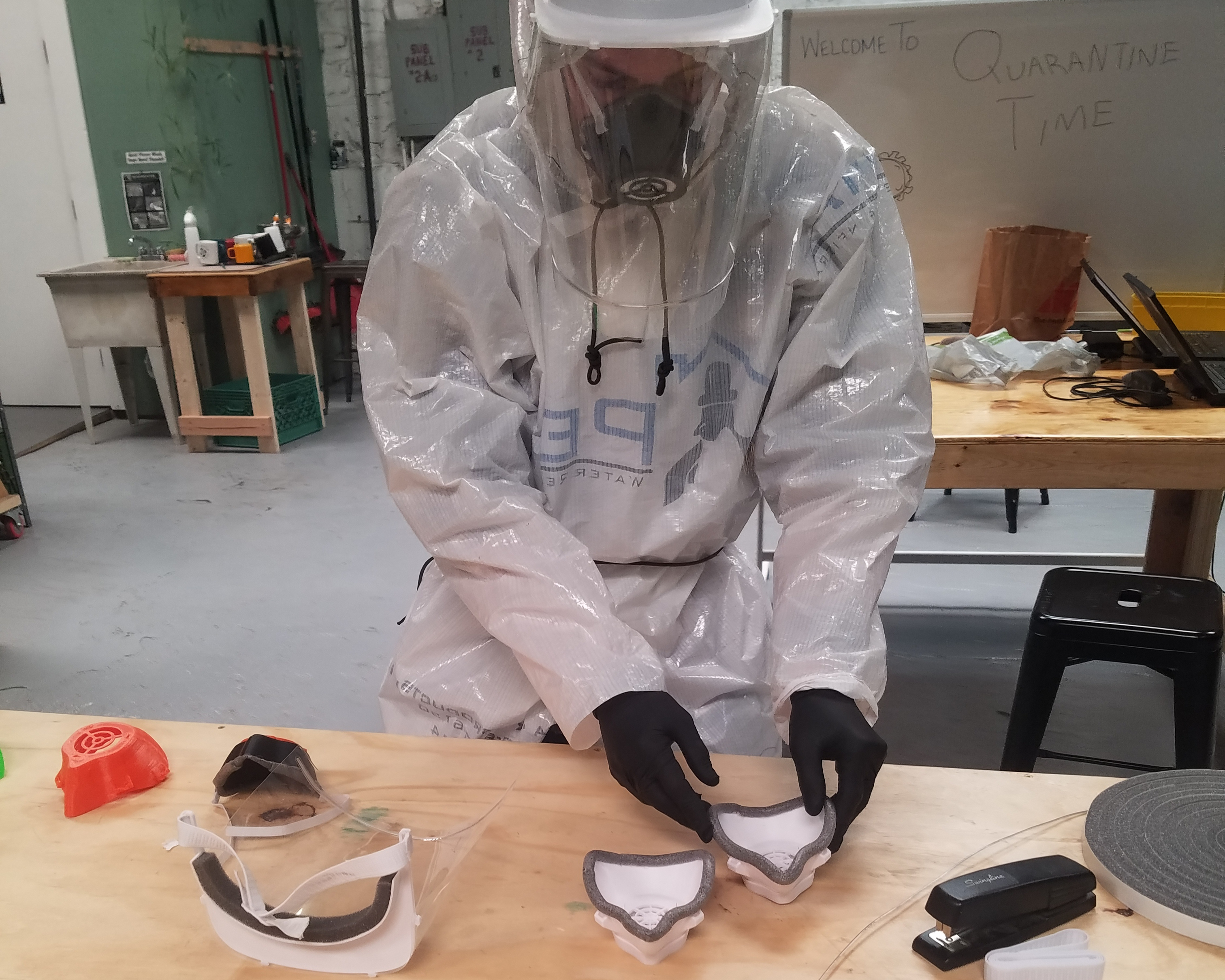Above: Danny Hicks, left, and other Socorro bus drivers shuttle more than 400 meals to kids in the school district. Photograph courtesy of Denise Cannon.
ADRENALINE MAY HAVE COLORED those first weeks of flattening the curve, fueled by the shock of so much change and a looming threat on the horizon. That jolt has been replaced by the sinking recognition of the marathon that lies ahead. This week’s True Heroes shared their resolve to last that distance. They’re still gathering strength and resources, recruiting volunteers, improving and expanding their efforts, and building systems and plans to better serve one another. We’re pausing now to thank those who have declared, We’re in it together, and we’re in it for as long as it takes.

Above: Danny Hicks and the Socorro bus drivers have kept delivering for the students of the district. Photograph courtesy of Denise Cannon.
Sack Lunch Shuttles
The first day Danny Hicks, transportation director for the Socorro School District, organized his bus drivers to deliver breakfasts and lunches to some of the district’s students, they visited 100 homes. On Friday, that number reached 460.
School administrators had gathered when schools closed to formulate a plan for how to keep feeding kids who depend on those meals but whose families couldn’t pick them up. Hicks asked if bus drivers could drop them off, along with homework packets. He guessed they’d start with 50. But from day one, he has faced more than twice that much need—and only continued to look for more.
“He’s knocking on doors, finding families, making sure any of our kids who need services are getting the food and the work and a big smile,” says Denise Cannon, assistant superintendent with the school district, who nominated Hicks.
Hicks commends the administrators who supported this effort and Francine Garcia, the food service director, who sends one hot meal a day—chicken fajitas, breakfast burritos, even pizza.
“It’s been really neat to see the kids,” Hicks says. “When you bring them pizza, they get really excited.”
He adds to his list almost daily, though the rate has slowed, and is now punctuated by requests to bring homework packets, too. With spotty internet service, online learning programs are fraught with frustration for some and out of reach for others.
“Whatever they need,” Hicks says. “The district is really trying to help to get them whatever they need.”

Above: Stephen Lindsey assembles 3-D-printed personal protective equipment at Future Forge Makerspace in Silver City. Photography courtesy of Stephen Lindsey
Forging On
People working at drive-through test sites had just one face shield to share among themselves, local hospital lab techs were short on protective equipment, and one Silver City health clinic was facing the potential of closing because of a shortage of those supplies.
When these stories reached Stephen Lindsey and Gabe Farley, co-founders of the nonprofit Future Forge Makerspace, they partnered with Ayshford Heneghan, a local science teacher, to fire up the maker space’s equipment.
“It was like, OK, I see there’s a big need,” Lindsey says.
They found guidelines and patterns online to make face shields, respirators, and technical gowns using the Future Forge’s sewing machines and 3-D printers. Lindsey schedules his days around resetting the printers to produce two face masks every three hours and works overnight on the nine-hour job of printing one respirator.
Already, they’ve donated more than 300 face shields. They’re still working on tweaking gown designs, hoping to produce one that’s air-pressured to provide the highest level of protection.
“We’re trying to do this because we believe it can help save lives,” Lindsey says.

Above: Cami Mallory, right, her daughter, Faith, and wife, Becca, started Families Feeding Families to help others in Socorro. Photography courtesy of Cami Mallory
A Growth Opportunity
Cami Mallory’s work started with just one family. Through social media, she heard about a family in Socorro who needed food and had no transportation to pick it up.
Mallory knows how that feels. She grew up in Seattle with a single mom and no car. When they took the bus to the food bank, they could only take what they could carry home. She learned to save part of her school lunches to have for dinner.
So Mallory, her wife, Becca, and their 11-year-old daughter decided to see what they could do to help. With donations from friends and neighbors and one trip to the store, they were able to supply that family with food for two weeks. On the drive home, they started talking about other Albuquerque families who might have similar needs.
“It wasn’t really a question of, ‘Should we do this?’ It was more, ‘We’re doing this. Now, how can we get the community to help us?’” Mallory says.
Mallory coordinates food deliveries for about 25 families out of her garage, which is lined with rows of totes, boxes, and small coolers to haul eggs, milk, fresh fruit, rice, beans, beef, and even pet food. She’s been shocked by how many people have offered help. She named the organization she’s now running for just what it is: Families Feeding Families. They’ll keep going, she says, as long as they have to.
“It’s just something that should be done,” Mallory says. “You help people when you can.”
Just a Little
All Sandy Ortega-Galvan needed was just a little formula to get her seven-month-old son through the 12-hour drive from Clovis to Houston, Texas, for surgery to repair a hole in his heart. But the store shelves were bare of the specific infant formula she needed. Desperate, she turned to friends, one of whom referred her to Rosemary Ward at ENMRSH, Inc., a family-focused nonprofit. Within the day, Ward got in touch with her supervisor, Jessi Stockwell, who headed out to leave a can of formula at Ortega-Galvan’s door.
“It’s hard, because everybody’s hoarding all this stuff and not thinking about everybody else,” says Ortega-Galvan, whose son returned home from the hospital this week. “So I was glad she helped me out.”

Above: The New Mexico Medical Reserve Corps has helped staff drive-through testing clinics and other important duties. Photograph courtesy of Bobbie MacKenzie
Calling in the Reserves
More than 3,700 doctors, nurses, physician assistants, counselors, emergency medical technicians, medical assistants, and medical and nursing students have volunteered with the New Mexico Medical Reserve Corps.
Pre-screened and trained to help whenever and wherever needed, these volunteers—from students to retirees to full-time staff willing to contribute their weekends—were called to action March 12, the day after New Mexico’s first COVID-19 cases were reported. They responded to a trickle at first, helping out at a few phone banks, but that demand is rising.
By the end of this week, Bobbie MacKenzie, state volunteer coordinator, estimates 185 volunteers will be deployed. They’re answering phones, staffing drive-through testing clinics, assisting at the homeless shelter in Albuquerque, helping COVID-19 patients in hotels and at a detox center, distributing food boxes from Road Runner Food Bank, and preparing to manage alternative care sites.
“By us running the alternative care sites, it’s leaving the doctors and nurses in the hospitals … to help with the higher-acuity-care patients,” MacKenzie says. “These are good-hearted people that just want to give to their communities.”
True Shout Outs
We’d like to take a moment to thank … the anonymous person who picked up the grocery bill for toilet paper, paper towels, detergent, and rubbing alcohol for another woman when her debit card was discovered missing in the check-out line … Albuquerque real estate agent and theater director Zane Barker, who has been shopping for anyone who needs help and thus braving grocery stores several times a week … and the volunteer staff at Albuquerque’s Presbyterian Kaseman Hospital, who provide food baskets to the elderly along with cheer and kindness.


